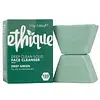What's inside
What's inside
 Key Ingredients
Key Ingredients

 Benefits
Benefits

 Concerns
Concerns

 Ingredients Side-by-side
Ingredients Side-by-side

Sodium Cocoyl Isethionate
CleansingStearic Acid
CleansingGlycerin
HumectantCocoyl Methyl Glucamide
Skin ConditioningKaolin
AbrasiveRicinus Communis Seed Oil
MaskingSodium Chloride
MaskingCitrus Aurantium Dulcis Peel Oil
MaskingLimonene
PerfumingSodium Isethionate
CleansingMica
Cosmetic ColorantCI 77891
Cosmetic ColorantCI 77491
Cosmetic ColorantCI 77492
Cosmetic ColorantCI 77499
Cosmetic ColorantCI 77288
Cosmetic ColorantCoconut Acid
CleansingWater
Skin ConditioningGlycerin
HumectantCoco-Glucoside
CleansingCocamidopropyl Betaine
CleansingXanthan Gum
EmulsifyingTriolein
Skin ConditioningPhenoxyethanol
PreservativeSodium Chloride
MaskingSodium Benzoate
MaskingSea Water
HumectantCamellia Sinensis Leaf Extract
AntimicrobialCitric Acid
BufferingCentella Asiatica Flower/Leaf/Stem Extract
Skin ConditioningHydrolyzed Rhodophyceae Extract
Tocopherol
AntioxidantEthylhexylglycerin
Skin Conditioning
 Reviews
Reviews

Ingredients Explained
These ingredients are found in both products.
Ingredients higher up in an ingredient list are typically present in a larger amount.
Glycerin is already naturally found in your skin. It helps moisturize and protect your skin.
A study from 2016 found glycerin to be more effective as a humectant than AHAs and hyaluronic acid.
As a humectant, it helps the skin stay hydrated by pulling moisture to your skin. The low molecular weight of glycerin allows it to pull moisture into the deeper layers of your skin.
Hydrated skin improves your skin barrier; Your skin barrier helps protect against irritants and bacteria.
Glycerin has also been found to have antimicrobial and antiviral properties. Due to these properties, glycerin is often used in wound and burn treatments.
In cosmetics, glycerin is usually derived from plants such as soybean or palm. However, it can also be sourced from animals, such as tallow or animal fat.
This ingredient is organic, colorless, odorless, and non-toxic.
Glycerin is the name for this ingredient in American English. British English uses Glycerol/Glycerine.
Learn more about GlycerinChances are, you eat sodium chloride every day. Sodium Chloride is also known as table salt.
This ingredient has many purposes in skincare: thickener, emulsifier, and exfoliator.
You'll most likely find this ingredient in cleansers where it is used to create a gel-like texture. As an emulsifier, it also prevents ingredients from separating.
There is much debate on whether this ingredient is comedogenic. The short answer - comedogenic ratings don't tell the whole story. Learn more about comegodenic ratings here.
The concensus about this ingredient causing acne seems to be divided. Research is needed to understand if this ingredient does cause acne.
Scrubs may use salt as the primary exfoliating ingredient.
Learn more about Sodium Chloride